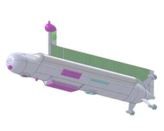NASA scientists have designed an autonomous submarine to be used to explore one of the seas of Titan, Saturn’s largest moon, which is the only object other than Earth where compelling evidence of stable bodies of surface liquid has been found.
They say their plan is to have this submarine travelling to Titan by the year 2040.
They propose that the submarine should be used to explore the Kraken Mare, a body of liquid detected by the unmanned spacecraft Cassini in 2007. It has since been identified as the largest body of water in Titan’s north.

The Titan submarine will beam messages to Earth when it surfaces, scientists say. (Image: hou.usra.edu)
Kraken Mare, which is believed to be up to 160 meters deep, was found to have small waves.
Sub’s design based on current aquatic drones
The aquatic drone would be able to cover 2,000 km over the course of 90 days. It would weigh about 1 tonne and is based on existing aquatic drones currently used on Earth.
As Titan will have no orbiter to relay data to Earth, the submarine would need a powerful transmission system to beam data through the liquid and then across over one billion miles of space. The researchers decided that it would not be practical to transmit while the sub was under water.
In the teams’ design, they have incorporated a planar phased-array antenna in the submarine’s dorsal fin. However, the additional bulk might complicate its maneuverability, as well as the placement of the buoyancy control tanks.
Data will be transmitted to Earth when the submarine surfaces. While on the liquid’s surface, the scientists plan to have a mast-mounted camera filming. Side-scan sonar will be used to map the lake’s floor while the sub is submerged, as well as a “benthic sampler” that will scoop up sediments for analysis.
Titan’s environment is very different from Earth’s
Nobody is sure what the lake is made of, most likely a combination of ethane and methane. The scientists have assumed it consists mainly of the heavier methane and have factored this greater density into the design of the submarine.
Another challenge for the NASA team is how to fill the buoyancy tanks with air in an environment could enough to condense Nitrogen into a liquid.
Landing the sub on Titan is also a serious problem. Submarines are not particularly aerodynamic, making it tricky to bring it down through the moon’s atmosphere and then onto the surface.
The NASA boffins propose packing the sub into a vehicle like the X-37 autonomous space plane which could handle a landing on water. It’s cargo bay would open after landing and the sub would be released.
The team, from the Universities Space Research Association in Houston, wrote:
“The vehicle would use conventional propulsors to yaw around, using a sun sensor to determine the initial azimuth to Earth (Earth is always within 6° of the Sun as seen from Saturn) and begin communication, using a terrestrial radio beacon as a more precise reference.”
Video – Is Titan similar to Earth?
Titan has many of the features found on Earth. It has a dense atmosphere and large bodies of liquid. This video is an artist’s impression of what the moon might look like close up.

